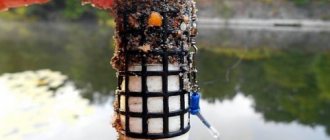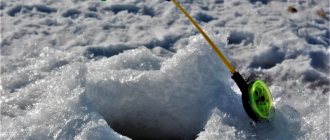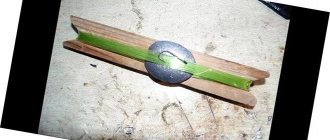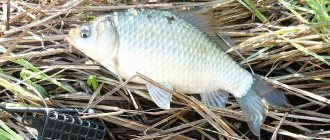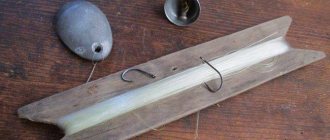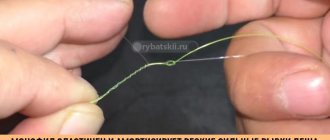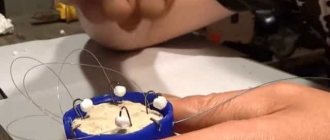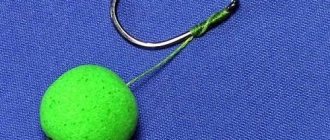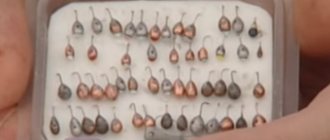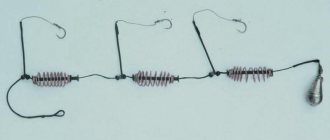Net with feeder. Fishing tackle review. How to catch it.
Now there are many offers on the Internet for the sale of a small net with a feeder , which can be cast either manually or using a spinning rod.
At the same time, fish swimming up to the feeder and swimming around the bait should theoretically become entangled in this net. How to fish with this gear is not described in detail anywhere. It is only reported that you need to press complementary food into the spring feeder (a special mixture for bait or just millet or pearl barley porridge) and throw the tackle in shallow water and wait for a “bite”. minigrid with feeder Chinese version
Since the design of the tackle is simple, you can make it yourself using a feeder and a piece of net fabric about 1.5 meters in size, or buy it from the Chinese via the Internet, where its cost ranges from 30 to 80 rubles per piece.
a trap-feeder net with a catch, a promised catch - American advertising.
There are a lot of opinions about this net, but one thing is for sure, with a fairly compact size, it combines the delights of fishing with biting, while the catch does not depend on the intensity of the fish’s hunger - the fish can only be caught by coming up to sniff the complementary food, while whether bait on a hook on a regular fishing rod - maybe she wouldn’t swallow it.
Russified instructions for fishing with a mininet with a feeder
Findfish feeder trap - where to buy, how to catch it and how to make it yourself.
installation diagram of a mini-grid with a feeder under ice
Experience of use has shown that the effectiveness of this gear can be compared to all known fishing scarves. You can also fish with these nets and feeders in winter . The net with the feeder is lowered into the hole to the bottom, and then raised by about 40 centimeters and left in this state, waiting for a fish to fall into it. Among the inconveniences of winter fishing, it should be noted that before lowering the tackle into the hole, its edges must be almost perfectly cleared of ice, otherwise a lump of net will cling to it and in this situation it will be difficult to drown the net.
photo of a net with a feeder when fishing from ice in winter
catch - fishing in winter
Of the gear I know, it reminds me of the good old “pioneer” - a roll of netting with a piece of white foam, which was thrown into the water on a rope, the fish, thinking that it was food (bread for example), swam up to it to look and got tangled in the net, at that moment it was pulled out . Used mainly for catching bleak.
Conclusion: a mini-net with a feeder has its advantages in terms of compactness and an element of sportiness - a “bite” can be seen, an element of descent may be present. Good maintainability. Efficiency is very average. In addition, it should be recalled that the tackle is, of course, poaching.
I bought it by mail here https://ali.pub/27irhe for about forty rubles apiece in a batch of 4 different sizes of yak. Sent very quickly. Although you can make such a feeder-trap with your own hands, in my opinion it’s easier to take a ready-made one.
Poscriptum . Fishing practice with a feeder net.
After playing with these devices a few times, I actually somehow abandoned them... But just last week we were fishing for bream - the bite was very bad - there was a feeling that the little thing was eating the bait, or the fish was very carefully trying what was on the hook...
I accidentally discovered 3 net traps in my backpack. I decided to try it.
I filled the feeders with porridge and lowered them to different depths: one net with a feeder at the bottom, the rest a meter higher. And... lo and behold, first one twitched, then the other! I'm dragging - a decent glander! Then 8 saberfish flew into the nets at once. As a result, in half an hour I caught about 4 kilograms of fish. During the same time, I managed to catch only one bream on the bottom. So the tackle, as I said above, can perform well under certain conditions!
RusCamping - exchange of experiences and opinions
Review and recommendations for fishing with feeder-trap gear.
Now there are many offers on the Internet for the sale of a small net with a feeder , which can be cast either manually or using a spinning rod. At the same time, fish swimming up to the feeder and swimming around the bait should theoretically become entangled in this net. How to fish with this gear is not described in detail anywhere. It is only reported that you need to press complementary food into the spring feeder (a special mixture for bait or just millet or pearl barley porridge) and throw the tackle in shallow water and wait for a “bite” - entanglement of fish or crayfish.
minigrid with feeder Chinese version
Since the design of the tackle is simple, you can make it yourself using a feeder and a piece of network fabric measuring about 1.5 meters, or buy it from the Chinese via the Internet, where its cost ranges from 30 to 80 rubles per piece. In markets and stores in Russia it is already a little more expensive.
net trap-feeder with a catch, the promised catch - American advertising.
There are a lot of opinions about this net, but one thing is for sure, with a fairly compact size, it combines the delights of fishing with biting, while the catch does not depend on the intensity of the fish’s hunger - the fish can only be caught by coming up to sniff the complementary food, while whether bait on a hook on a regular fishing rod - maybe she wouldn’t swallow it.
What kind and how many fish can you catch with this feeder-trap or as it is now called - FindFish?
Russified instructions for fishing with a mininet with a feeder The principle of fishing with a net with a feeder is not similar to a fishing scarf, but therefore the efficiency here is higher, since, unlike the wall of a scarf, this net catches in any direction - the fish will not pass along the canvas. The mesh is not loaded, sewn in the shape of a cone, used fluffed, i.e. it creates a net volume in which the fish feed on the food falling out of the feeder. In summer, the feeder can be equipped with a float and cast from the shore, in winter into a hole (see diagrams below). When fishing from ice, a net with a feeder is lowered into the hole to the bottom, and then raised by about 50 centimeters and left in this state, waiting for fish to fall into it. For sportiness, you can put it on a nod made of ordinary willow rod.
method of placing in a bundle vertically
Another way to install feeder nets is to place them in a bunch one above the other - the number depends on the depth of the reservoir. The length of the tackle can be increased directly on the water by attaching one feeder-trap to another. With this setup, the lower feeder with the net lies on the bottom, the rest are located at half-water and the upper one is almost on the surface. This installation option is also good because from the first fish caught you can understand at what level in the water column the fish is kept.
A predator often gets caught in such a net with a feeder, as it hunts for fish that feed near the feeder. To prove this, you can watch video reviews on our website, where you can see how both perch and pike perch are caught in the gear.
installation diagram of a mini-grid with a feeder under ice
Findfish feeder trap - where to buy, how to catch it and how to make it yourself.
By the way, of course, it’s easier to buy such tackle rather than make it yourself, but making it yourself is also not difficult at all - we make a springy feeder, which we fill with complementary foods and tie a piece of net fabric about a square meter in size to a swivel attached to its bottom.
Experience of use has shown that the effectiveness of this gear can be equal to all known fishing scarves. You can also fish with these nets and feeders in winter . The net with the feeder is lowered into the hole to the bottom, and then raised by about 40 centimeters and left in this state, waiting for a fish to fall into it. Among the inconveniences of winter fishing, it should be noted that before lowering the tackle into the hole, its edges must be almost perfectly cleared of ice, otherwise a lump of net will cling to it and in this situation it will be difficult to drown the net. That is, putting this gear on for several days, checking it regularly is a bit of a chore.
photo of a net with a feeder when fishing from ice in winter
catch - fishing in winter
Of the gear I know, it reminds me of the good old “pioneer” - a roll of netting with a piece of white foam, which was thrown into the water on a rope, the fish, thinking that it was food (bread for example), swam up to it to look and got tangled in the net, at that moment it was pulled out . Used mainly for catching bleak.
In the photo on the right is my catch in a net with a feeder on the first ice - I put one in for testing - in 3 hours I caught 1 crayfish and 3 good roaches!
Conclusion: a mini-net with a feeder has its advantages in terms of compactness and an element of sportiness - a “bite” can be seen, an element of descent may be present. Good maintainability. Efficiency is very average. In addition, it should be recalled that the tackle is, of course, poaching.
I bought it by mail here https://ali.pub/27irhe for about forty rubles apiece in a batch of 4 different sizes of yak. Sent very quickly. Although you can make such a feeder-trap with your own hands, in my opinion it’s easier to take a ready-made one. Well, given the cheap price, take at least a dozen - then fishing will definitely be more fun.
As an option, such a mesh feeder can also be supplemented, for example, with a baby bird, as in the video below. Then, when catching live bait, you can additionally please yourself with a larger fish, which, as a rule, usually always manages to escape when the little fish rises...
Poscriptum . Fishing practice with a feeder net. Personal experience using a mesh feeder.
After playing with these devices a few times, I actually somehow abandoned them... But just last week we were fishing for bream - the bite was very bad - there was a feeling that the little thing was eating the bait, or the fish was very carefully trying what was on the hook...
I accidentally discovered 3 net traps in my backpack. I decided to try it.
I filled the feeders with porridge and lowered them to different depths: one net with a feeder at the bottom, the rest a meter higher. And... lo and behold! First one twitched, then the other! I'm dragging - a decent sapa! Then 8 saberfish flew into the nets at once. As a result, in half an hour I caught about 4 kilograms of fish. During the same time, I managed to catch only one bream on the bottom. So the tackle, as I said above, can perform well under certain conditions!
If necessary, I will film and post a video here with instructions on how to fish with these nets and feeders correctly! Although there are a lot of them on YouTube - they mostly fish with a fishing rod or spinning rod - in open water and in a hole - in winter.
I’m glad if you liked the material on the site and the article!
Feeder trap with fishing net
When going to a pond, every fisherman mentally imagines returning home with a fish tank filled to the brim with fish. But, unfortunately, fishing is a kind of lottery. Yesterday I caught it, today I’m empty-handed, and what will happen tomorrow is unknown.
There are many reasons why fishermen often fail. These are weather surprises, the capriciousness of the inhabitants of rivers and lakes, lack of experience and a number of other factors. How to deal with this? Is there a way to guarantee results? There is, and this is not an ultrasonic fishing rod, for which you can be seriously punished, but an innovative fishing tackle - a Findfish feeder-trap with a mesh. She is the winning ticket in the lottery called “FISHING”. If supporters of traditional fishing rods, donks and spinning rods catch as much as they can, then a fisherman using a feeder-trap always catches as many fish as he wants. Moreover, in any weather and in a variety of conditions.
Feeder trap - what is it?
Externally, the feeder-trap with a fishing net is similar to the ancient devices with the help of which the population of Asia once provided themselves with fresh fish. In some countries such devices are still used today. Manufacturers of fishing gear and accessories became interested in them and filled the market with modern, improved analogues that were worthy competition for sports gear. Now such a device can be purchased in the USA, Europe and the CIS countries. The best feeder in this category is the Findfish trap feeder, which resembles the well-known parachute, but it is used in a completely different way. A feeder with a small canvas is thrown in a promising place and they wait for the fish, attracted by the smell of food, to become entangled in the net. This method of fishing does not require deep knowledge of fishing or any special skills; you just need to throw the trap into the water and wait for a bite.
Feeder trap
Don’t be nervous, I’m comparing))))) let’s see what’s written here.
Feeder trap for fishing. This fishing tackle is one of the oldest. Its analogues are widely used in Asia. And in our country, many fishermen are familiar with similar designs - Klondike and Pioneer. However, a mesh feeder trap has a more advanced design. Equally suitable for fishing in fresh and salt water.
A feeder-trap for fishing is a simple tackle reminiscent of fishing with a “TV”, “Klondike” and “Pionerka”. The principle of operation has been known since ancient times. Fun to make and fish!
Fishing is like a lottery. Therefore, it is better to consolidate moral satisfaction from the fishing process with delicious field cuisine. It’s good to prepare them before the fresh fish reaches your hands. For such treats, according to tradition, it is convenient to buy top quality stew
.
Natural large-piece military stew Voyskoi Spetsrezerv is a hearty ingredient for cooking. Camping recipes with army stew
will delight you with its gastronomic properties, regardless of the fishing result.
Fishing Features
The device consists of a spring feeder and a small mesh fabric in the shape of a cone (up to 1.5 meters), knitted from a thin tenacious nylon fishing line. You can cast it manually or using a spinning rod, after filling the feeder with a fragrant bait mixture. The latter will fall to the bottom, and the net will unravel and float freely in the water until a hungry fish falls into it. When this happens, the tip of the spinning rod will “play”, signaling to the angler that it is time to take the prey. In addition, the trap can be combined with a float rod. In this case, the float, or rather its behavior, will tell you when to pull it out.
The same spring-type feeders are used in the crucian carp killer bottom rig, but they are equipped with hooks rather than mesh. What is the difference? The fish may not be interested in the bait attached to the hook, and will get entangled in the net as soon as it attempts to approach the food. By the way, if you really strain your memory, you can remember the domestic prototype of a feeder-trap with a fishing net. This is a good old pioneer, consisting of a piece of mesh fabric and foam, which was thrown into the water with the expectation that a curious fish would be trapped. I must say, she caught regularly, especially large bleak.
Feeder-trap device
The fishing feeder-trap has a simple design. The gear consists of a net trap with a spring (volume) type feeder. The mesh is very thin, light and tenacious. It is attached with a regular carabiner connection.
It is convenient to use fishing tackle both from the shore and from a boat. Most often, a spinning rod is used for fastening.
It is no less effective to attach the structure to a regular fishing rod. Or it could be a simple bait without a rod. The structure is attached to a regular fishing line on a reel.
The signal that a fish is caught in the net will be the twitching of the tip of the fishing rod. But it’s even better if a float is installed on the line.
Advantages of gear
Compared to other fishing methods, a feeder equipped with a mininet has a number of obvious advantages. The following can be named:
- high efficiency (no one is left without a catch);
- simplicity, clarity and ease of use;
- the tackle is suitable for any reservoir, both fresh water and salt water;
- catches not only peaceful fish, but also predators that always follow the food fish;
- there is no need to wait for good weather, you can always fish, regardless of the season, time of day, etc.;
- successfully used both from the shore and from a boat;
- good maintainability (an accidentally torn section can simply be tied up);
- there is a certain amount of sportiness in fishing (it is not necessary to leave the tackle, for example, overnight, the fish can be pulled out after the bite);
- accessibility (the feeder-trap is quite inexpensive);
- possibility of choice (feeders are equipped with nets with different mesh sizes).
The above is enough to have no doubt that the Findfish feeder-trap is a necessary thing for fishing. Especially in those moments when, due to instability of atmospheric pressure and other unfavorable weather phenomena, many species of fish become capricious and refuse to take even the most catchy baits. With such gear there are no idle trips.
See how the tackle works
in winter
With float
For bottom tackle
How many fish can you catch with this FindFish feeder?
• The principle of fishing with a net with a feeder is not similar to a fishing scarf and therefore the efficiency is higher. The mesh is not loaded, sewn in the shape of a cone, used in a fluffy form, i.e. it creates a net volume in which the fish feed on the food falling out of the feeder.
Read also: Chokeberry wine in a 3 liter jar
• In summer, the feeder can be equipped with a float and cast from the shore.
• Due to its compactness, this fishing tackle can be used for winter fishing. The net with the feeder is lowered into the hole to the bottom, and then raised by about 40 centimeters and left in this state, waiting for a fish to fall into it.
• Oddly enough, a predator very often gets caught in such a net with a feeder, since it hunts for fish that feed near the feeder. To prove this, you can watch video reviews on our website, where you can see how both perch and pike perch are caught in the gear.
• You don't have to wait for a bite, so you'll catch a lot more fish than with regular fishing.
The feeder trap can be used both in WINTER and SUMMER
“Ukha and frying are as simple as shelling pears. "
I always love something new, so I was interested in this kind of gear. The SHIMANO spinning rod is very convenient and compact due to the telescope, which is not the case with plug-in spinning rods that take up a lot of space and are always ready in the car. I'm not a very professional fisherman, but I liked this FindFish feeder right away. I don’t need a lot of fish, so when I arrive at the dacha I can catch it in half an hour with a fryer and that’s enough for us. And we also make hot smoked fish right away, it’s incomparable. Your PROFI bait works flawlessly. I mix it with water to make a mixture like plasticine and then press it into the feeder. I am very pleased with the purchase. Thank you!
Dmitry Ryazantsev, Barnaul
Feeder trap FindFish 6 PIECES with different meshes
- Feeder trap made of Japanese fishing line 0.17 mm
- Mesh 27-30 mm (2 pcs)
- Mesh 35 mm (2 pcs)
- Mesh 40-45 mm (2 pcs)
- Weight 5 g
The most popular spinning rod Shimano Catana
- Folded length 0.6 m
- Operating length 2.7 m
- Ring type – Anodized steel+cermet
- Blank – Telescope
- Comfortable handle
- Material – Carbon + Geofibre (Kevlar fiber)
FOR ONLY RUR 2,190
OR YOU CAN ORDER
6 pcs. FOR ONLY 990 RUB.
6 pcs. and 12 pcs. even MORE PROFITABLE!
12 pcs. FOR ONLY RUB 1,490.
18 pcs. FOR ONLY 1990 rub.
Conclusion: The FindFish feeder trap, according to reviews from fishermen, is gaining popularity in Russia. The net with the feeder in the water is straightened out in the shape of a cone and the fish, swimming up to the feeder, falls into the net. At the same time, a bite occurs on the fishing rod and you can pull the tackle ashore. 3 cone-shaped feeder traps with different mesh sizes will allow you to hunt fish of different sizes. Previously, you could only buy a Chinese network with a feeder. Now you can buy a net with a feeder in Russia from the FindFish company.
- This fishing method is permitted!
- You can catch fish soup or fish fry in less than 30 minutes.
- You get 6 gears with meshes for different sizes of fish, so with the FindFish feeder trap you will always have a catch, even if there is no bite.
Read also: Lamp for plants white light
- Only on our website you get the legendary Shimano Catana spinning rod at a price 2 times lower than in regular stores.
- When you order, you receive a ready-made set of gear for 100% of your catches.
- With us you get a 100% quality guarantee on all gear. And also a guarantee of exchange of goods or a full refund if for some reason it does not suit you.
Wait for hours for a bite
Spend money on bait and tackle
Wait for suitable weather for fishing
You can fish in any body of water where there are fish. With the Findfish feeder trap you can easily fish both from the shore and from a boat.
Can be used both WINTER and SUMMER
The FindFish feeder trap has been tested and tested in various reservoirs in winter and summer.
According to reviews from our customers, the FindFish feeder trap has proven to be most successful when catching the following types of fish:
- crucian carp
- carp
- roach
- carp
- silver bream
- ide
- pike
- white bream
- dace
- chub
- silver bream
- tench
- perch
- zander
- bleak
- chebak
- rudd
- bream
- minnow
- peled
- saberfish
The FindFish trap is a great gift for yourself, a friend or loved ones! Treat yourself to new experiences and catches!
BEWARE OF DISHONEST SELLERS!
Dear customers, be careful.
We receive complaints on our hotline 8-800-551-9544.
Scammers have appeared on the Internet.
There are more and more cases when goods worth 50-100 rubles are sent in parcels instead of fishing gear.
They make copies of our sites and trade as official suppliers of the Profi Fish brand, which does not exist!
1. Fraudsters are usually attracted by lower prices; their websites do not have the phone number 8-800-55-195-44 and the official FisherGoMan or FindFish logo.
2. 8-800-551-9544 is the only telephone number in the Russian Federation that belongs to the company that owns the FindFish and FisherGoMan trademarks in the Russian Federation, which is confirmed by a Rospatent certificate.
3. After payment and receipt of the package from them, you will not have any opportunity to return, exchange the goods or contact the seller.
4. We send parcels without prepayment and (optional) with an inventory (inspection of the goods before payment).
You risk absolutely nothing!
On the official FindFish website YOU MAKE SAFE PURCHASES
You can place an order and ask all questions on the hotline by calling toll-free at 8-800-551-9544
You can also contact us at any time before ordering a product or after receiving it to clarify any questions, and you can also exchange or return the product.
Feeder trap FindFish 6 PIECES with different meshes
- Feeder trap made of Japanese fishing line 0.17 mm
- Mesh 27-30 mm (2 pcs)
- Mesh 35 mm (2 pcs)
- Mesh 40-45 mm (2 pcs)
- Weight 5 g
Read also: How a quartz heater works
The most popular spinning rod Shimano Catana
- Folded length 0.6 m
- Operating length 2.7 m
- Ring type – Anodized steel + Ceramic metal
- Blank – Telescope
- Comfortable handle
- Material – Carbon + Geofibre (Kevlar fiber)
Every third man on earth loves fishing, and every fourth of them uses his own gadgets, or rather methods of fishing. In this article I want to write about the manufacturing method and fishing from a boat using a “trap feeder”. This method is suitable for catching pure fish, but sometimes a predator doesn’t mind getting caught on the hook.
Where to buy a feeder trap?
Such devices are not sold in fishing stores; you can only find homemade copies of low quality. Outwardly they look neat, but after the first cast the fake immediately reveals itself. As a rule, it has too heavy a mesh fabric, which instantly sinks without having time to straighten out. That is why it is better to buy a trap feeder on the manufacturer’s official website. This will save money and protect the nervous system.
It is advisable to take a ready-made kit, which includes a strong carbon spinning rod 2.7 meters long and three feeders with meshes of different cell sizes. Why choose a “stick” if experts have already found the best option? Moreover, the cost of the finished set is more than acceptable.
Characteristic data
Do-it-yourself fishing feeder has a lot of varieties. Depending on the characteristic data, a gradation was created.
According to the size of the feeder there are:
- small, used when fishing for small-sized fish, for example, crucian carp, roach, bream;
- average;
- big.
The last two variations are used when fishing for carp.
As for the weight of the fishing feeder, it depends on the place chosen for fishing. So, if fishing is carried out during the current, the feeder is made heavier. Fastening is carried out on feeder or carp tackle.
When fishing in a river with a current, it is highly not recommended to use round-shaped feeders, as they will be carried away by it.
Depending on the type of bait holding, feeders are:
- closed, in which live food is placed;
- open, filled with porridge or plant food;
- winter ones, from which food falls to the bottom of the reservoir.
Types of feeders
The main advantage of fishing feeders is the ability to make them yourself, using improvised means.
Mesh feeders
Nowadays, mesh is the most common material for making feeders. Firstly, you can get it at any hardware store, both plastic and metal. Secondly, it is easy to work with, even while fishing.
- A fragment of approximately 4.5*10 cm is cut out of the mesh fabric. The dimensions may vary depending on what kind of fishing the feeder will be used for.
- A strip of 2*10 cm is cut out from a piece of lead plate.
- Now the mesh is rolled up to form a cone or cylinder. The joint line is crimped with a lead plate.
- The final touch in making a feeder with a net for catching fish is to use wire to make a fastening through which the fishing line will be connected to the feeder.
If there is a problem with the mesh, you can make it yourself from a plastic bottle, from which you cut out a rectangular piece of a suitable size, roll it into a cylinder and make holes using a hot nail.
Wire feeders
They are used for fishing on water with little current. Their sizes can be different, since it depends on what cross-section of the wire was taken for work. The larger the diameter of the wire, the more spacious the fishing feeder. The spring model is considered the simplest and looks like a spiral.
- Take brass and copper wire of small cross-section. You will also need a nut 1.5-2 cm in diameter (optionally, a steel rod).
- Using tools, wire is wound onto a rod; the number of turns should vary from 6 to 10 pieces, and the distance between them depends on what kind of food will then be placed in the feeder.
- The resulting spring is removed and using your fingers it is given a barrel shape.
- Next, a plastic or iron rod (tube) is installed inside the spring and the outer turns of the spiral are securely fastened to it.
For fishing on the river or at distances far from the shore, it is more rational to use a spring feeder made of rigid steel wire.
Plastic stopper in action
From available materials (an ordinary plastic bottle cap) you can prepare the simplest and fastest homemade fishing feeder, called a smoktukha or nipple. It is excellent for fishing for carp, carp, crucian carp, and bream.
- A round fragment with a diameter identical to the bottom of the plug is cut out of a piece of sheet lead.
- Using an awl (if you don’t have one, you can take a nail), two holes are made in the lead circle and the bottom of the lid.
- A soft wire is passed through the holes made so that the lead weight is on the outside, and the ends are twisted inside the plug.
- The next step is to use a nail to punch holes (3-4 are enough) on the side walls.
- A wire ring is attached to one of the holes, and leashes equipped with hooks are attached to the others.
- The final step is to prepare a dough of viscous consistency, which is used to fill the prepared teat feeder. Hooks are hidden in the dough. The point is that the fish, starting to suck the dough, will definitely swallow the hook with it and voila, your catch.
Now you know how to make a fishing feeder simply, quickly and using ordinary materials. But remember, they can get lost during fishing, so it’s better to prepare feeders for future use so as not to waste precious time.
DIY feeder feeders
Today’s article in the “Do It Yourself” section is truly dedicated to those who love and can make fishing tackle with their own hands. With this article we begin such an extensive section of the production of feeder gear as: creating feeder feeders with your own hands.
The following method for making feeder feeders may seem relatively difficult and requires a rather complex technology. But, as life tells us, there are many craftsmen in our country, and for them this is not such a difficult task.
And having managed to cast the shape of the weight for the feeder with your own hands, you will provide yourself and your friends with durable and cheap gear for the feeder.
Many may ask: why do this routine work? Well, first of all, as we already said: this is for those who want to do something on their own with their own hands. Secondly: when fishing, the consumption of feeder feeders can be quite high, and their prices, although not so high, but combined with other expenses that we make before each fishing trip, are still affordable.
When describing the production of forms for a feeder, it should be noted that here one of the variants of the form is presented, and you, based on your experience and the conditions of fishing on the feeder, can simplify or modify something.
At the beginning of any business, you need to carefully think through everything, collect the necessary material, tools, auxiliary equipment and determine the place for work.
So here's what we need.
- steel blanks 2 pieces 60mm by 80mm, 10mm thick;
- two pieces of wire 6mm in diameter and 20mm long;
- auxiliary blank, 30mm by 80mm, 5mm thick;
- metal mesh with a cell of 4–6 mm, depending on its structure.
- hacksaw for metal;
- drill, or better yet, a drilling machine;
- mites;
- hammer;
- anvil;
- scriber;
- punch;
- calipers;
- pencil and ruler;
- drills 6mm and 16mm,
- crucible (metal container) for melting lead;
- scales.
Let's start by selecting the necessary material, namely a steel bar, 60mm by 80mm and 10mm thick and an auxiliary 30mm by 80mm, 5mm thick. Let's make sure that the metal is soft (tempered); if not, then it is necessary to remove the hardening.
We cut two blanks 60mm by 80mm and one 30mm by 80mm.
We will fold the prepared blanks so that the two main ones are on the outside, and the auxiliary one is in the middle and in the middle (sorry for the tautology, but I can’t describe it any other way), aligned along the length of 80mm.
We need an auxiliary blank to obtain an ellipse-shaped casting. This shape suits my fishing conditions and gives stability on the ground and the necessary strength to the feeder itself.
The resulting “sandwich” must be securely combined and secured, if possible, secured by welding at the ends.
Let's secure our assembly in a vice with the short side up. (see photo)
From the corners at a distance of 10 mm from the top and side, we mark the holes for future stoppers of the two halves of the molds. We core and use a 6mm drill to drill through holes.
We decide how we will tighten our forms. I suggest using stoppers, but you can also tighten them with M6 bolts, for example. To do this, you need to cut a thread on one of the sides. If you choose locking pins, cut 2 pieces of 6mm wire each 20mm long.
Immediately grind one side of the pins lightly to a length of 10mm, so that they fit into the holes without play. And drive the untreated 10 mm ones under the countersunk into one of the halves. If there is shat, boil the potai.
Read also Hydrangea photo indoor propagation
As a next step, we mark and core the middle point, our “sandwich”. We clamp it in a vice, paying special attention to the reliability and stability of the fastening.
Let's center the drilling machine so that the hole is strictly perpendicular to the top surface. Mark the immersion depth on the drill so that there is 3-5mm left before the drill exits. We'll go through it with a 6mm drill and then with a 16mm drill.
Let's unpack the details. We remove the 30 by 5mm plate. Combine the resulting two halves and clamp them in a vice again. Use a hacksaw to cut off the excess material, marking 16-17mm from the edge.
On top we leave hangers that are also 16mm. (see photo)
Then, for ease of casting, we make a countersunk hole and expand the neck with a 16mm drill.
We take the mesh for the feeder and cut out a strip of mesh approximately 50mm by 80mm.
Apply a 50mm edge to the side of one of the halves and mark the spots for the mesh. It is necessary to make symmetrical cuts on both sides of the form to the depth and profile of the mesh.
From suitable wire we will make an eyelet for attaching the feeder trough. And we’ll cut through two holes for this ear, ensuring a tight fit between the two halves. All that remains is to grind off the sharp corners and sand down the rough edges for ease of use.
Preparation of casting lead, tin
If we want to set up small production, then we need to prepare blanks for lead casting. Melt scrap lead in a strong bowl. Using a sliver, slightly tilting the dish, remove scale and other debris to the metal surface. Then, using a metal corner, we cast strips of lead.
Giving shape and weight to the feeder
We cut the mesh blanks. In my case, the maximum size of the mesh and, accordingly, the resulting feeder will be 5 cells. If necessary, you can reduce the size of the feeder. If we fill the entire height of the mold with lead, we will get the maximum weight. If you need to reduce weight, then fill in less lead.
It is better to have feeders of different weights in stock and select them according to fishing conditions.
When making our own, we select the necessary parameters: the feeder mesh can be changed in height and width, giving it a different shape. You can make a round, square and triangular profile of the feeder. And depending on the amount of lead poured in, you can adjust its weight.
The mesh can be different, both stamped and wire.
When making feeder feeders and any other weights with your own hands, you need to remember safety precautions.
Both lead and tin, as well as their alloys, are suitable for casting. When melting, oxides and scale appear. They are somewhat poisonous, and if you decide to make feeders with your own hands, then you need to do the work in the open air or under a hood. Under no circumstances should there be water or fat in the crucible or on the lead. It is necessary to work with glasses and gloves, with a stable burner and a reliable crucible.
And in conclusion. If you love and are ready to do something yourself, then you can master the basics of casting and the production of molds for casting weights. What one person could do, many can do, especially hardworking people like feeder fishing enthusiasts.
I believe that in the production process, the most important thing is to make a good mold for casting lead, or better yet several. Once the shapes are good, and with the acquisition of certain skills, the process of making feeders will be simple and enjoyable.
Feeders can be powder coated. We have already described the method of painting fishing sinkers on our website.
As a result, you can get original items that are in no way inferior to purchased branded items.
The site “Fishing on the Feeder” and I personally wish you that your own feeders will be the most catchy and always come back).
Homemade feeders for fishing on the feeder
Homemade feeder method
How to make a feeder for a feeder
Homemade feeder feeders
Making feeder feeders with your own hands
Homemade feeders for feeders
Net with feeder. Fishing tackle review. How to catch
.
Read also: Calcium for broilers instructions
minigrid with feeder Chinese version
promised catch - South American advertising
Russified annotation on fishing with a mininet with a feeder
At the moment, there are many offers on the Internet for the sale of a small net with a feeder , which can be cast either manually or using a spinning rod. with all this, the fish swimming up to the feeder, swimming around the bait, at a theoretical level should get entangled in this net. How to fish with this gear carefully is not described anywhere. It is only reported that it is necessary to press complementary food into the spring feeder (a special mixture for bait, in other words, simply millet, pearl barley porridge) and, throwing the tackle in shallow water, wait for a “bite”.
Because the design of the tackle is ordinary, you can make it yourself using a feeder feeder and a piece of net fabric about 1.5 meters in size, or you can purchase it from the Chinese via the Internet, where its price ranges from 30 to 80 rubles per piece.
